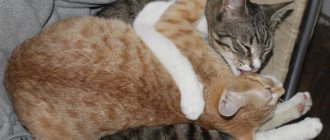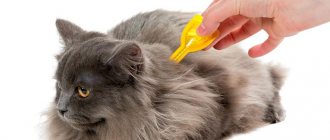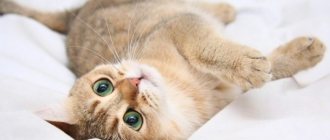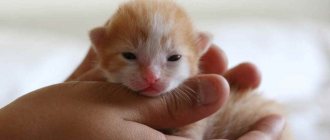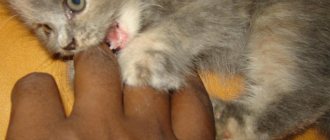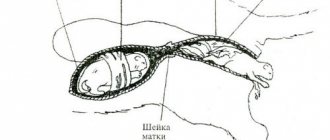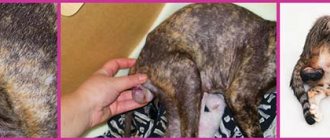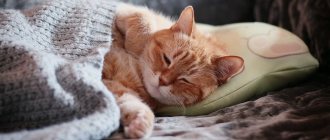Why detect a cat's pregnancy in the early stages?
Despite the fact that a cat's body is designed to survive in the wild, care and monitoring of pregnancy are very important. The sooner the owner finds out that she is pregnant, the more time she will have to prepare for the arrival of the babies.
For your information! The ability to bear kittens occurs at different ages in each breed. For example, British cats are ready for their first pregnancy only after 1 year of life.
It is especially important to monitor the condition of purebred animals (for example, sphinxes, folds). Some breeds may have difficulties during pregnancy and birth. In addition to being monitored by a veterinarian, owners must be able to independently handle the cat during labor if assistance is needed.
It is advisable to immediately find out if your cat is pregnant so that if something happens, you can help her with childbirth.
In ordinary (eg Scottish) cats, pregnancy takes 9 weeks, which averages 62-65 days. Representatives of large breeds (Maine Coon) bear kittens for about 10 weeks, which corresponds to 65-72 days.
"Sex machines" and pregnancy
Our favorite cat = Nut. Editorial cat.
If you have a British child, then know that he is at risk.
Siamese cat
And, of course, it’s worth mentioning the unique sex machines in cat form. British and Siamese cats tend to yell (beg for a cat) during almost the entire pregnancy . And the most temperamental cats, fortunately, are very rare; some kittens are fed, others are carried, and others have already been identified and require a cat.
When can a cat become pregnant?
A cat is ready to become a mother for the first time at the age of 5 to 9 months, but this period may shift. There are many factors that influence an animal's reproductive process. Body size, breed, general health and even the length of daylight hours all matter in one way or another. As a result, the age of a cat for the first pregnancy can vary from 3.5 (that is, pregnancy occurs even in small kittens) to 18 months.
Readiness to mate is expressed by peculiar behavior: the cat becomes very restless, constantly demands attention, may sleep less and eat worse. In addition, a characteristic pose appears when the cat falls on its front paws, arches its lower back, rolls on the floor and purrs or meows invitingly.
There are pathologies with similar symptoms that can be confused with a real pregnancy:
- false pregnancy;
- ascites;
- tumors.
How do these conditions differ from true pregnancy? In case of a false pregnancy, a cat exhibits absolutely all the symptoms, except for one thing – the kittens do not move at the prescribed period. With ascites and tumors, there is nothing but an enlargement of the abdomen from fluid accumulated in the abdominal cavity or the growth of the tumor itself in the abdominal cavity.
Both conditions are considered abnormal in the cat's health and require veterinary intervention. If there are no signs of a normal pregnancy in a cat, you should immediately take it to a veterinary clinic for examination.
Possible problems and solutions
The pregnancy period in cats is one of the most dangerous for the animal.
At this time, the expectant mother’s body is greatly weakened, so the likelihood of getting injured as a result of an unsuccessful jump or contracting an infection increases.
Owners who are experiencing a cat’s pregnancy for the first time may be overprotective of their pet, worry greatly about the most normal phenomena in this situation, fear for the health of the animal and constantly take it to the veterinarian.
Photo: During pregnancy, a cat’s body is vulnerable to diseases and infections
Sometimes people, wanting to provide the best care for a pregnant cat at home, overdo it, arrange luxurious spacious houses with heating pads or literally feed it with vitamins.
Very soon a miracle will happen: your cat will give birth to cute fluffy kittens! And with them, your pet and you will have new worries.
At what stage can pregnancy be determined?
How to understand that a dog is pregnant: signs in the early stages
You can visually recognize a cat’s pregnancy only by the animal’s changed behavior. A month after fertilization, the sides of the abdomen and swollen nipples become noticeable.
You can find out about pregnancy in the early stages from your veterinarian. In hospital settings, ultrasound is performed starting from the 20th day after fertilization. At 25 days, an analysis is done at the veterinary clinic, and after 26-30 days, the doctor palpates the abdomen to determine the presence of a fetus. Another way is an x-ray, but it can be done starting from the 40th day.
The first signs are below.
Changes in appetite
To answer the question of how to determine if a cat is pregnant, you need to monitor your pet’s behavior. In the first weeks after mating, the animal's appetite rarely decreases. Sometimes vomiting is observed in the morning.
Unfortunately, vomiting can be the cause of many diseases, in particular worms. Therefore, if this sign is present, it is advisable not to delay and take the cat to the veterinarian.
From the middle of pregnancy, the appetite grows rapidly, so during the process of bearing kittens, a cat can gain up to 3 kg.
Changes in behavior
A possible pregnancy can be determined by changes in the animal's character and behavior. At first, the cat behaves slightly aggressively.
From the second half of gestation of kittens, the cat’s behavior changes in the opposite direction. She looks affectionate and gentle, and tries to spend most of her time with her owner.
The cat is very affectionate and loving
Not all cats exhibit characteristic changes in behavior. Some pets behave normally throughout pregnancy. Significant changes are observed at the moment before birth. The expectant mother begins to look for a secluded place, behaves restlessly and prefers to be alone.
Termination of heat
The main sign of pregnancy is the absence of estrus. It is this factor that allows you to determine the exact probability of fertilization.
After the estrus stops, the cat begins to behave calmer, stops showing interest in cats, and does not ask to go for a walk.
Changing the color and size of the nipples
To check for pregnancy, you need to look at the animal's nipples. A few weeks after conception, they swell and change color. The color of the nipples becomes much brighter and takes on a pink-red hue. The color changes most intensely when the cat is in position for the first time.
Important! Swelling of the nipples also occurs during estrus, so this sign alone should not be taken into account.
The first appearance of colostrum occurs a week before birth. The initial composition of the secretions contains a large amount of protein and fats; over time, the amount of substances changes slightly.
The desire for comfort and arrangement of a sleeping place
The less time remains before giving birth, the more the cat begins to fuss. She chooses a comfortable place where the babies will be born in the future. To prevent her from giving birth on her owners’ bed or in another inappropriate place, it is necessary to create a secluded corner for the cat in advance.
In addition to maintaining comfortable conditions, it is necessary:
- ensure complete peace of mind;
- limit the cat’s communication with other animals;
- monitor the cleanliness and hygiene of the animal;
- Provide clean water and balanced food.
Nesting
This symptom is characteristic of late pregnancy. At this moment, the cat begins to prepare for the upcoming birth. She often chooses a suitable place herself, but the owners can help her by providing her with a cozy nest. First of all, it should be cozy, warm and protected from drafts.
In recent days, a pregnant cat begins to look for a secluded corner
Drowsiness and apathy
Signs of a cat's pregnancy often include decreased activity and frequent sleepiness, which are a consequence of hormonal changes. Active and playful cats prefer to sleep most of the day in the first weeks of pregnancy. At this time, they usually have a decreased appetite, due to which the animals are physically unable to be active.
Note! In later stages, the animal’s condition improves, but the cat cannot be playful due to its growing belly.
HEALTH
- Is it possible to vaccinate a pregnant cat? - This is not advisable, since vaccination can cause the development of diseases in the fetus.
– How to rid a pregnant cat of fleas? – It is best to treat fleas before pregnancy, but if they are still present, it would be better to treat with a mild treatment such as Frontline spray. Please note that the drug must have a note stating that this product is suitable for pregnant cats and kittens up to 3 weeks.
– What to do if a pregnant cat is found to have worms? – If this is found, then it is necessary to treat the cat with mild preparations, for example, drontal for cats or dosalid. Please note that the drug must have a note stating that this product is suitable for pregnant cats and kittens up to 3 weeks.
- Is this a pathology if a pregnant cat has a larger belly on one side than the other? - No, this may be due to the uneven location of the fetuses in the cavity of the uterine horns.
- What can cause bleeding in a pregnant cat? - Either with the onset of the birth process, or with pathology of the uterus.
– What does discharge in a pregnant cat indicate? - Most often this is due to the presence of an infection of the uterus or vagina.
– Are diarrhea and vomiting a dangerous symptom in a pregnant cat? – Such symptoms usually indicate poisoning with something that requires appropriate treatment.
– A pregnant cat sneezes often. What could this be? - This can be associated either with a cold or with the presence of diseases of the upper respiratory tract, more often with polyps of the nasal passages.
– What to do if a pregnant cat falls from a height, but no changes in behavior are observed? How to determine whether the kittens are injured? - It is necessary to perform an ultrasound of the uterus to determine bleeding and viability of the fetuses.
– Does your pregnant cat have brown growths between the hairs on her chin? What is it and what causes it? - Most likely, it is acne - skin lesions associated with excess sebum production. This manifests itself with a decrease in immunity or with the development of certain metabolic diseases.
- Is it possible to sterilize a pregnant cat? - If the cat’s owner simply does not want unplanned kittens, then such an operation is not entirely ethical, because the owner should have taken care of the cat’s safety in advance. The only justifiable reason for performing such an operation during pregnancy is a threat to the health of the mother cat due to illness.
What changes occur before childbirth?
Cats mature at 6–7 months. It is during this period or a little later that they have their first heat. However, the body needs a few more months to fully develop. Mating is carried out only for the third time of sexual heat. The optimal age is about one and a half years.
The cat is looked for in advance, especially during breeding. The female and male are preliminarily checked for the presence of infections, viruses, and anomalies. Two weeks before mating, preventive deworming is carried out.
The cat is not washed immediately before mating. Water and cosmetics destroy the natural odor that attracts the male. The meeting is scheduled for 3–5 days from the start of estrus. This is the most productive period when the probability of fertilization is highest. To do this, they usually choose “male” territory.
The fact that a cat is ready for sexual intercourse upon meeting is indicated by flirting with a sexual partner. Owners should be on alert, because animals can be injured during mating games.
The duration of one sexual act is 30 seconds. At the same time, the cat purrs, and the partner responds with a loud cry. During coitus, an egg is released from the ovaries, and fertilization occurs within 24 hours. Mating can be repeated 5–8 times. When the process is over, the cat begins to roll on its back, and the cat moves away and licks itself to the side.
Mating in cats
Sometimes the cat is left with a partner
It is very important for the owner to know the due date, because it is unknown how this process will go, and it may be necessary to provide assistance to the pet. You can find out when this period is approaching using the following signs:
- About 3 days before the onset of birth, the cat begins to look for a secluded corner, she looks for a suitable place, and begins to build a nest. To prevent this process from happening on your bed, it is best to prepare for it in advance. You can offer her a box covered with a warm cloth and a sheet on top.
- The cat's nipples sharply increase in size, from which colostrum is secreted. Mucus discharge is observed from the genitals.
- The temperature drops sharply by about 1 degree and can reach 37 degrees.
- 10 hours before the birth of the offspring, the pet hides in its nest. There is no need to disturb her; you can help at this stage by providing fresh water.
The decision has been made, now we need to wait for the right moment. In young females, sexual desire is often weak. But each time the desire to become a mother will become stronger, and the pet will demonstrate it more and more often. Under optimal conditions, a cat can give birth twice a year, but she can only be bred if she is in good physical shape.
Calendar in a matter of days
First week
The first week after mating of a female with a male passes without a trace. The fertilized egg does not reveal itself in any way, so the owners will not immediately be able to understand whether the cat got pregnant or not. But it is during this first week that if the sperm reaches the egg, it fertilizes it. Next, the fertilized egg begins to move; it will move to its home for the near future - the uterus.
Second week
In the second week (from the eighth to the fourteenth day), moving eggs reach the uterus. After which they plunge into it, and the process of forming kittens begins.
Third - fourth week
Over the next two weeks (from the fourteenth day to the twenty-seventh), the conceived embryos enter the process of organ development. For these reasons, the cat's hormonal levels change dramatically, which can affect its mood, appetite and sleep. Also, by its appearance it will already be possible to recognize that the cat is pregnant. Because her nipples drop lower (swell) and can be either dark or pink.
It is during this third and fourth week of pregnancy that the cat may feel gag reflexes, so it will refuse even its most favorite food. There may also be vomiting, so it is necessary to monitor the animal very carefully, because if it is very frequent and the cat feels very unwell, then it is necessary to show it to the veterinarian.
At about 4 months of pregnancy, an experienced doctor can already feel the babies in the belly of the pet, however, this is best done with the help of an ultrasound. It is during this period that the cat should be carefully protected and taken good care of. Do not lift the cat under any circumstances, as you may crush the kittens. It is especially important to consult your children on this issue.
Fifth week
In the fifth week, if you have not found out that your cat is pregnant, it is time to show her to the doctor. Using palpation or ultrasound, the doctor will tell you whether there is a pregnancy, how it is progressing and how many kittens the expectant mother is carrying.
Sixth - seventh week
Starting from the sixth week of pregnancy (from thirty-five to forty-two days), you can see the kittens moving in the womb, of course, if your female is not too fluffy. It is during this period that her health should improve, so a good appetite may awaken. Do not deny anything to a pregnant woman! Give as much as she wants to eat, remembering that she feeds not only herself, but also future offspring. At the same time, food must be of high quality and balanced.
Eighth week
With the onset of the fiftieth day after conception (eighth week), the cat begins to carefully care for itself. Her nipples become even larger, more prominent and pinker. During this period, the cat may shed heavily; this is normal while bearing cubs. Thus, the cat seems to be preparing for childbirth. After the kittens are born, the fur will definitely grow back.
As this week progresses, the cat's appetite may decrease as the fast-growing kittens take over all the space in their mother's tummy (and do not overfeed the cat too much, as the kittens may outgrow and the cat will have a difficult time giving birth). The closer to childbirth, the more likely it is that the female begins to look for a place to give birth. If you notice something strange in her behavior, try placing a box or basket in which you place a sterile soft cloth.
During this period, you can very easily feel the presence of babies in the cat’s womb. And also the release of milk from the cat’s nipples indicates that the body is already preparing for the birth of new offspring. You can easily see this because very often it dries out at the ends of the nipples.
The ninth week is a harbinger of labor
In principle, by the behavior of the expectant mother, you can notice the onset of labor, because she:
- may feel restless;
- do not leave your owners;
- meow for no reason;
- hiding in your birthing nest.
How to tell if your cat is late in pregnancy
How to understand that a cat loves you - signs of your pet's feelings
How to understand that a cat is pregnant and in late stages:
- the presence of embryos in the abdomen is determined by palpation;
- nipples swell and change color;
- Appetite improves dramatically, and taste preferences may also change;
- the cat looks fatter as the belly is rounded on the sides;
- in the later stages, the movement of the babies is felt.
General information
On average, a cat's pregnancy lasts 55-70 days; the larger the breed, the longer the cat bears kittens. But the problem of determining whether conception has taken place is the same for all purebred and outbred cats - until the 25th day you will definitely not be able to check the presence of fetuses in the uterus. Yes, there are signs of successful conception that apply after a planned mating, but all of them can also be the consequences of a false pregnancy. And it is especially difficult to determine whether a cat is pregnant or not if the animal has free access to the street or even lives in the local area without constant supervision.
Signs of successful mating
In order not to wait in vain for something that may not happen, it is advisable for owners of mustachioed pets to navigate the main manifestations of a successful mating. Of course, it is impossible to track the process if animals have free access to the street.
But if the individual is purebred and is constantly looking for a suitable partner, then mating occurs under the control of the owners, so that there is confidence that the coverage is complete. Time will tell whether fertilization occurred or did not occur, but the question of the quality of mating should be excluded.
Basic conditions for successful mating
- The favorable period for mating is considered to be the period between 3 and 5 days from the start of estrus;
- It is better to take the female to the male and it is better from the first day of sexual heat. The cat is not immediately allowed in, but the female is given the opportunity to get used to the situation in someone else’s home;
- Don’t be surprised when on the first day the animals hiss at each other, throw themselves and scratch – this is a natural process of “getting to know each other”. There is no need to interfere too much. At the same time, there is no need to let each other be scratched to death either;
- wait for the cat’s initiative (females are the first to start “flirting” with the male);
- When mating begins, the animals must not be disturbed or distracted so that the male does not suddenly lose interest in the process.
Main manifestations of full coverage
- the cat falls on its side, begins to roll, turning from side to side, sometimes purring;
- the genitals (mucous membrane) swell somewhat (slight swelling against the background of a rush of blood), acquiring a more saturated color than usual;
- the cat usually loses interest in the cat, moves away, and begins to actively lick its genitals;
- if the cat continues to show interest in the female, she will no longer let him near her;
- after 1-3 days, sexual hunting (estrus) ended.
After the above described phenomena, you can take your pet home, starting to wait for the first signs of the cat’s pregnancy.
How to distinguish a false pregnancy from a real one
In some cases, indoor and outdoor cats suffer from false pregnancy. The causes of the pathology can be:
- sudden stress or emotional overstrain in the pet;
- mating with a sick cat;
- improper functioning of hormonal levels;
- being near a pregnant cat.
How to understand that a dog is dying: signs of impending death
Only a veterinarian can check for a false form of pregnancy. Using an ultrasound, the cat's uterus is examined. The absence of kittens in the womb indicates the development of pathologies in the pet’s body. Treatment is prescribed depending on the cause and form of the disease. Therapy is often carried out using hormonal agents.
Important! It is necessary to understand that false pregnancy poses a serious threat to the cat’s life. Therefore, ignoring the problem can lead to serious consequences.
An animal's pregnancy may be false.
Preparing for childbirth
Owners must prepare for childbirth and create comfortable conditions for her. Within a week, a structure is installed in which the woman in labor will hide. A box with a low side, a bed, etc. is suitable. The area should be large so that the mother and kittens do not feel crowded. You should also ensure that people have access to this box in case assistance is needed.
For childbirth, you need to prepare a first aid kit
In this case, the veterinary first aid kit should contain the following items:
- disposable and flannel diapers (used for lining and covering kittens);
- pieces of textile the size of a handkerchief for wiping (gauze is not suitable);
- chlorhexidine or alcohol for cleaning tools and hands;
- the smallest size syringe for removing fluid from the noses of kittens;
- to lubricate the loop during difficult labor - sterile petroleum jelly and a pipette;
- brilliant green for lubricating the umbilical cord;
- cotton buds;
- a heating pad for the bed of newborn kittens;
- scissors washed with boiling water with blades rounded at the ends;
- scales.
The following medications are included in the first aid kit:
- calcium gluconate in solution for injection - stimulates contractions;
- Mastomethrin - stops inflammation, disinfects;
- Travmatin - relieves pain during childbirth, regulates the strength of contractions.
Procreation is a basic instinct in animals
Pregnancy is a difficult period in the life of a female, including cats. It largely depends on the person how the gestation of kittens will go and whether the offspring will be healthy.
Rules for caring for newborn kittens
Diagnosis of pregnancy
To be sure of your cat's position, the veterinary clinic offers the following procedures.
Ultrasound (ultrasound sonography)
It is not always easy to determine whether an outdoor cat or an indoor cat is pregnant based on one sign. Difficulties often arise in the early stages, when even the veterinarian cannot confirm the pet’s position.
Diagnosis in the clinic is carried out from the 20th day after conception using ultrasound therapy. Before the procedure, you must consult with a veterinarian in advance and find out how to prepare the animal for examination.
For your information! Ultrasound sonography allows you to establish not only the fact of pregnancy, but also find out the number of fetuses in the uterus, as well as identify pathological abnormalities. A cat examination does not take much time; the ultrasound procedure is safe for the animal and future kittens.
After diagnosis, the doctor will give the owner step-by-step instructions for caring for the cat before and after birth.
Ultrasound examination is by far the most common procedure, which gives 100% results in a few minutes.
Feeling the abdomen (palpation)
For palpation, the animal should be taken to a veterinarian, since independent palpation can harm the animal and small kittens.
The cat on the veterinary table must be kept in a standing position, it should not lie down. The doctor places his hands on both sides of the abdomen and gently palpates the area down to the lumbar region. In the early stages, only small compactions in the uterus can be felt, but in later stages, individual fruits are already noticeable.
Note! To understand that the animal is in position, an experienced doctor only needs a couple of minutes.
X-ray
X-ray is considered the most harmful method of examination. It was used before the advent of ultrasound. In the early stages, the procedure does not give the desired result, so it must be used in the last weeks. It is impossible to determine the presence of pregnancy in this way, but you can determine the exact number of kittens.
Today, X-rays are used extremely rarely when ultrasound does not give proper results.
Lab tests
This diagnosis is carried out in a clinic, where venous blood and urine are taken from the cat. During pregnancy, processes occur in the animal’s body that change hormonal levels and release special substances. As a result, biochemical analysis shows a complete physiological picture and confirms fertilization.
For your information! In cats, the hormone responsible for pregnancy is called relaxin. This is what is detected as a result of rapid tests. It is recommended to conduct research starting from the 26th day after mating. It is during this period that the active formation of the placenta and the production of hormones occur.
Having learned that a cat is pregnant, you need to make every effort so that she gives birth to healthy babies without consequences for herself.
This test can also be performed to determine a false pregnancy. In this case, the analysis shows the absence of the necessary hormone in the blood. The advantage of laboratory tests is a quick result, which is known within 10-15 minutes.
When planning to breed an animal, every owner should be prepared for a quick replenishment. To eliminate problems and provide your cat with maximum comfort, you need to know the main signs of successful conception. In this way, the owner can help the pet bear healthy kittens, as well as prepare the cat for the upcoming birth. It is also important to visit a veterinarian in a timely manner, who will help determine the number of fetuses, as well as identify deviations.
Animal behavior
Pregnant cats also change their behavior. From the first weeks, you can notice that expectant mothers become inactive: they will not play with you, jump, jump with the same desire, they prefer to spend more time lying down, sleeping longer.
Sometimes a cat can show anxiety: look under furniture, sniff things, meow. Try to calm her down, and the worries will pass.
Also, pets become more affectionate and sociable. They will follow the person and look for support, laying down next to you.
Photo: pregnant cats are inactive
The cat can climb onto your bed, snuggle and fall asleep, so she will feel calmer. Don't send her away. Spend time with your mother cat more often, this will help calm her down.
Pregnant pets sometimes surprise their owners with sudden changes in mood and behavior. She may be sleepy in the morning, but start running in the evening. A usually sociable cat may become quiet for a while and try not to be seen.
Don't be offended by her if she hisses at you for no apparent reason - pregnant cats are prone to mood swings. After a while, she will definitely come up with a purring apology.
In the last weeks of pregnancy, cats become heavy and can no longer jump onto their favorite chair with the same ease. Try to help them. It will be better if by this time you have already made a “nest” that will stand on the floor.
Caring for a pregnant cat
Veterinarians say that caring for a pregnant cat should be approximately the same as caring for a woman carrying a child. This is a serious burden on the body, which can fail at any moment. Owners must:
- visit a veterinary clinic and undergo an examination;
- keep the tray clean;
- finds time to play and communicate with the pet;
- Maintain body hygiene by brushing often;
- take care of the absence of fleas (a safe remedy will be recommended by a doctor).
Pregnancy is a reason to visit a veterinarian.
If your cat needs to be bathed, it is better to consult a doctor first. In this case, use only special shampoo for cats. Then the animal is moved to a warm corner without drafts.
During pregnancy, the cat’s habitat must be made as comfortable and safe as possible - remove high scratching posts and complexes where she likes to play.
Nutritional needs change throughout pregnancy. The first two weeks, when appetite increases slightly, the daily portion is increased by 10%. In this case, the entire volume of food is divided not into 2 meals, as usual, but into 4–5. From 3 to 7 weeks, the amount of feed is doubled from the original. Over the last fortnight, my appetite has decreased slightly as the fruits put pressure on my internal organs.
Pregnant cats have a good appetite.
The diet should not contain foods from the human table, especially those containing chemical additives - chips, sausages, smoked meats, including fish. This is harmful to all domestic animals, and their benefits for humans are questionable.
Nomes for feeding cats
Cat breeders have not yet come to a consensus on which food is better - industrial or natural. But they agree on one thing: if it is ready-made food, then it must be the highest quality available. Switching to a different type of diet will do more harm than good.
Cat breeders never tire of arguing about which food is best.
Royal Canin Queen
Acana Pacifica
Bozita
Josera Minette for kittens and nursing cats
These brands fall into the holistic and premium categories. They contain a sufficient amount of fat, protein, and amino acids to provide the expectant mother with energy for pregnancy and strengthen her immune system.
Kitten food is one of the options for complete nutrition for a pregnant or lactating cat.
In addition to the main diet, from time to time you can pamper your cat with natural products - meat, cottage cheese, yogurt. But then this is a delicacy, not the main food.
Many sources on cat nutrition note that it is not worth giving additional vitamins and minerals, since everything necessary is included in the product. Only a veterinarian can determine the possible need for supplements.
We invite you to familiarize yourself with the process of giving birth to a British Shorthair cat.
Natural nutrition
Breeders pay special attention to the natural nutrition of the cat.
Table 2. Qualitative composition of the diet of a pregnant cat.
| Name | Quantity, % |
| Squirrels | 25 |
| Carbohydrates | 25 |
| Fats | 12 |
| Cellulose | 2-3 |
| Minerals | 6 |
| Water | 29-30 |
Cats usually refuse plant foods. But if you grind it in a blender to a puree and mix it with meat products, then its taste buds can be deceived. You should not cut food into cubes, since only meat pieces will be selected from the plate.
A cat needs the following products:
- dietary meat - chicken, veal, beef (can be raw, but only fresh and high quality);
- sometimes - boiled fish;
- eggs - 2 pcs. in Week;
- low-fat dairy group - cottage cheese, yogurt, sour cream, cream, yogurt;
- cereals - oatmeal, rice, buckwheat;
- jelly, boiled cartilage.
Natural products are necessary for a pregnant cat.
For constipation, the cat is given beets and the amount of vegetable fat is increased. But they are excluded or the dose is reduced after the condition has stabilized.
Breeders recommend giving cats an infusion of raspberry leaves. It is prepared from a tablespoon of dry raw materials and a glass of boiling water, left for 15 minutes and filtered. Give a tablespoon 2 times a day from the beginning to the end of pregnancy. This will help bear healthy offspring and simplify the birth process.
In the second half of pregnancy, pre-scalded nettle leaves are added to the drink. These greens promote milk production.
Nettle decoction increases the amount of breast milk
It is necessary to ensure the presence in the diet of vitamins A, D, E, B1, B6, B1, as well as calcium, phosphorus, iron, iodine. Taurine, a sulfur-containing amino acid, is extremely important. If the diet is prepared correctly and is not monotonous, the body receives most of these elements from food. But with an unbalanced diet, vitamin preparations with the listed substances are necessary.
The following brands offer vitamin complexes for pregnant cats:
- Beaphar (Top 10 Cat, Salvical, Irish Cal);
- Brewers Yeast 8 in 1;
- Anivital FeliImmun and others.
Vitamin preparations will provide vital elements.
In cats, the opportunity for fertilization appears after the onset of puberty. For the first 6 months, the cat is considered a kitten, and you don’t have to think about pregnancy yet. But in order to further determine a cat’s pregnancy and its timing, you need to become familiar with the concept of estrus in an animal.
A cat's heat is the beginning of puberty.
A cat's heat is the onset of puberty, therefore the period when a cat can become pregnant for the first time. For the owner, this will be a signal about the animal’s ability to fertilize after mating with a cat.
Some features of the onset and course of pregnancy:
- During the year, a cat may come into heat 2-3 times;
- during the period of heat, the pet changes greatly in behavior: it falls to the floor and begins to rub its stomach and back, while meowing without stopping, it can rub against people, sometimes it makes marks around the house;
During the period of estrus, your pet changes a lot in behavior
- at the beginning of estrus, days 1 and 2, the cat loses its appetite, meowing becomes loud and intense, however, when meeting a cat these days, the cat may not let him near her, but after the first days of estrus, the cat will be ready for mating;
- It is quite rare to see a pregnant cat after the start of her first heat; fertilization usually occurs as a result of several meetings with the opposite sex;
If the owner has a need to sterilize a pet, then it should be remembered that this procedure is best carried out in a cat after pregnancy, first or secondary, it does not matter, the main thing is to know how to correctly determine the moment of puberty and only then contact a specialist.
The diet should not contain foods from the human table, especially those containing chemical additives - chips, sausages, smoked meats, including fish. This is harmful to all domestic animals, and their benefits for humans are questionable.
Pregnancy is a test for a cat’s body. Since all vital organs work in an intensive mode, the animal requires special care and attention. Favorable conditions play a big role in the course and outcome of the condition.
The cat should be kept in a spacious, well-ventilated room without drafts at a comfortable temperature. High humidity and dark lighting are unacceptable.
You should ensure that your cat does not climb onto high furniture, as a fall or awkward landing can lead to serious consequences.
In the later stages, you should help the cat with hygiene, since the large size of the abdomen does not allow the cat to carry out the necessary toileting of the genitals and fur.
What to feed
The general principles of feeding a pregnant cat include following some rules:
- The diet should consist of high-quality feed, rich in all necessary substances.
- It is recommended to provide easily digestible food.
- A pregnant cat requires more frequent feeding. By the second trimester, the daily norm increases by about 50%.
- In the later stages, you should resort to fractional meals 6 times a day.
- It is important to regularly check the presence of water in the drinking bowl. Dehydration leads to abortion, which can cause the death of the cat.
How long is the gestation period in cats?
An important question for the owner is how long a cat’s pregnancy lasts. The average length of pregnancy for a cat is 59 days. However, the gestational age of a cat largely depends on the age of the expectant mother, breed, and individual characteristics. The duration of a cat's pregnancy can be 55–62 days.
The first thing to remember is the time from which pregnancy begins - from the moment of mating and fertilization and at the end of this period with childbirth. The average gestation period for kittens ranges from 62 to 68 days. In cases of premature birth, kittens appear dead.
But this does not apply to all cat breeds; there have been cases where Siamese representatives gave birth to offspring on the 71st day of pregnancy, and the kittens were alive and completely healthy.
A typical cat pregnancy lasts 9 weeks - 55 to 63 days. This period also varies depending on the breed and number of kittens. For example, in cats of Siamese and Oriental breeds, pregnancy sometimes lasts longer than 9 weeks. Multiple pregnancies often lead to a shorter term.
For those planning to breed kittens, it is interesting to know how many pregnancies cats can have per year. Domestic cats are capable of bearing offspring up to three times a year, but this, of course, is a lot of stress for their body. According to veterinarians, it is advisable for a cat to give birth to kittens no more than once a year.
Behavior depending on the timing of estrus (estrus)
Questions are often asked about why, after mating, a cat continues to ask for a cat and behaves restlessly. Most often, her behavior depends on what day of estrus the mating occurred. That is, the same animal at different periods of life can behave differently only because mating occurred at the beginning or at the very end of estrus.
The fact is that on different days of estrus, the body’s reaction to sexual intercourse will be completely different due to the different amounts of sex hormones released in the body.
First 4-5 days
The duration of estrus is individual for each cat, on average it lasts a week or two. In the case of productive mating during the first days, estrus will continue for the required amount of time.
The cat will behave as if pregnancy has not occurred, requiring further contact with the cat. However, they should not be allowed, so that a situation does not arise with the presence of fetuses in the uterus at different dates, which often leads to the birth of dead kittens or severe exhaustion of the pet.
It is extremely rare that behavior changes, and the fertilized female immediately calms down. Most often this happens after many days of contact.
Mid-estrus
If fertilization occurred on days 5-7, and the standard duration of estrus in a cat does not exceed 10 days, then after mating the animal can calm down and behave as usual. If the cycle is longer, then she continues to show anxiety. But such an active search for the cat is no longer observed.
End of estrus
Over the last 3-4 days, there has been a gradual stabilization of hormonal levels, so after mating the pet almost always begins to behave absolutely calmly, but this largely depends on its character.
Cat behavior just before labor begins
If the initial period of pregnancy is missed due to the owner’s carelessness, you should know how to determine the onset of labor in a cat.
Most cats do not require assistance with their kittens.
A few days before lambing, the animal may completely stop eating, and its behavior becomes quite nervous. During this period, you can notice how the stomach drops, water flows out, the shade of which is gray with a red admixture. Labor can last about a day.
Most cats do not require assistance when giving birth to kittens; they are able to gnaw the umbilical cord themselves using their teeth. However, not all animals are the same, which is why some cats ask their owners for help.
Some cats will still need help, and during pregnancy you should pay more careful attention to your pet
During the postpartum period, the animal should be helped to recover by showing care. It is worth treating the mammary glands to prevent bacteria from entering.
Precursors of childbirth and the appearance of kittens
Normally, a cat's pregnancy lasts up to 65 days, but a delay of up to 71 days is considered non-critical. A few days before giving birth, the cat begins lactation - the production of colostrum, which looks like a clear or yellowish liquid.
1–2 days before giving birth, the cat’s base body temperature drops. If normally the temperature ranges from 37.7 to 39.1 degrees, then before birth it can drop to 37 degrees. This is normal and does not require intervention or treatment. With a decrease in body temperature, the cat may seem more apathetic, but as the experience of owners shows, most expectant mothers behave anxiously.
During the last week of pregnancy, especially after the cat's temperature has dropped, she should be kept in a separate room. Move the water bowl, feeder and tray to the nest so that the cat does not have to waste extra energy. During childbirth, a young mother has poor control over her body temperature, so it is important to monitor the humidity and temperature in the room. Kittens, immediately after birth, quickly become hypothermic, so if necessary, a heating pad is placed in the nest.
We suggest you read: Diseases of chinchillas and their treatment at home || How to treat a chinchilla
Contractions indicate the beginning of the labor process. The interval between the first contractions can last up to 30 minutes. As the experience of owners shows, the first contractions may go unnoticed. Immediately before labor, pushing begins and is preceded by contractions less than 30 seconds apart.
By the time labor begins, you should have the following kit on hand:
- Several pairs of sterile surgical gloves.
- Pipette or syringe to remove mucus from the respiratory tract of kittens.
- Antiseptic, dental or cotton floss for tying the umbilical cord - useful if the cat loses too much strength in pushing.
- Sharp, sterile scissors.
- Clean, soft towels and moisture-wicking diapers.
- Cat milk replacer.
- Warmer.
- The number of the 24-hour veterinary service or the veterinarian who saw the cat during pregnancy.
The appearance of each kitten consists of four stages: contractions and pushing, birth of the kitten, expulsion of the placenta. It can take 10 to 12 hours from the start of contractions to the birth of the first kitten. During this period, the cervix will dilate and the kittens will move along the birth canal.
About a day before giving birth or just before contractions, a mucus plug will come out of the birth canal. This stage may go unnoticed if the cat went to the litter box to empty its bladder or bowels. During pregnancy, the mucus plug protects the cervix and protects the kittens from infections.
The second stage is pushing. Pushing is the contractile activity of the uterus, which pushes the kittens into the birth canal. The more pressure is applied to the cervix, the more the cat will push. Normally, after the start of pushing, no more than 10 minutes pass until the amniotic sac with the kitten appears. Pushing for an hour indicates a protracted labor, and in this case it is better to consult a veterinarian.
Immediately after the bubble appears, the cat chews it and actively licks the kitten. If the presentation is correct, the kitten is born head first. The cat actively licks the kitten's face, freeing its respiratory tract from mucus.
Normally, immediately after the birth of a kitten, the placenta comes out of the birth canal. The afterbirth looks like a small piece of liver and is connected to the kitten by the umbilical cord. If everything goes without complications, the cat independently gnaws the umbilical cord and eats the afterbirth.
How pregnancy manifests itself in different breeds: Scottish Fold cat
photo from the website: www.pets4homes.co.uk Already in the first days after conception, the favorite Scottish Fold breed begins to signal the owner about her situation - she becomes drowsy and eats more and more. To support the body during this difficult period for the animal, you can give your pet vitamins with a high calcium content. Some females develop toxicosis between 3 and 4 weeks, and on days 21-28 of pregnancy, the nipples of the future nurse swell and change color.
It is still not recommended to feel the enlarged belly on your own - it is better to entrust this to a veterinarian, who will not only palpate, but also do an ultrasound to make sure that the fetus is developing correctly. If there are children in the house, explain to them that a pregnant cat cannot be picked up - it can be harmed with one awkward touch.
By the middle of the term, it is necessary to increase the number of meals per day - from 2-3 to 4-5. The diet must include:
- boiled lean fish;
- hard-boiled eggs;
- porridge from rice, buckwheat, oatmeal;
- low-fat cottage cheese;
- vegetables and fruits as a necessary natural source of vitamins.
The last point will be especially relevant if the cat has constipation - in this case, you can give her beet puree. To improve lactation, Scottish Folds are given a salad of nettle leaves - they are finely chopped and doused with boiling water.
MOMENT
– Does a cat bleed during heat?
– No, cats usually don’t bleed. If you notice blood after a heat, it could be a miscarriage. You should see a doctor. – How to reliably determine whether a cat is pregnant? Are there any special pregnancy tests for cats? - There are no special tests. The only reliable diagnostic method is ultrasound examination (ultrasound). It is carried out starting from the 30th day of pregnancy of the cat.
– Can a pregnant cat ask for a cat? – Usually no, this does not correspond to normal levels of hormones in the blood. If this is the case, then the cat has a pathology.
– How to distinguish a real pregnancy from a false one? – False pregnancy is a neuropsychic disease of an animal in which, after a certain period after estrus, usually two months, the animal begins to show signs of pregnancy: lactation, withdrawal, certain toys appear, which the animal nurses as its own offspring. This pathology is more common in dogs.
– Does a cat have to gain weight? Does it happen that a cat’s pregnancy is almost unnoticeable? - Some cats do not change their constitution until the last days, and by appearance it can be difficult to distinguish a pregnant cat from a non-pregnant one.
Results
Also, be attentive to signs of toxicosis in a cat, because pregnancy can lead to exacerbations of various diseases and nausea and vomiting will then not be side effects from hormonal changes, but symptoms of the disease. If vomiting is profuse and not related to the time of day, contact your veterinarian.
Also, in the early stages after controlled mating, you can do a test for the hormone relaxin, which acts as feline hCG, on the 20th day.
IMPORTANT: if there are two cats living in your house and one of them becomes pregnant, then monitor the reaction to this event in the second female. The cat world is structured in such a way that the second madam can imagine a false pregnancy. Then it is worth showing her to a veterinarian and carrying out hormonal treatment, because a false pregnancy does not benefit either the physical or mental health of the animal.
